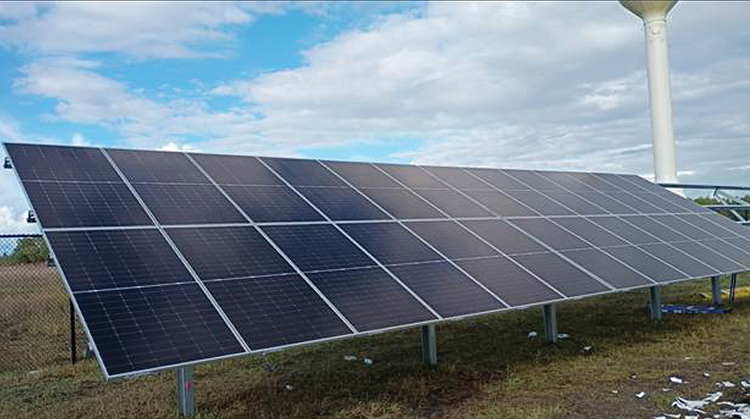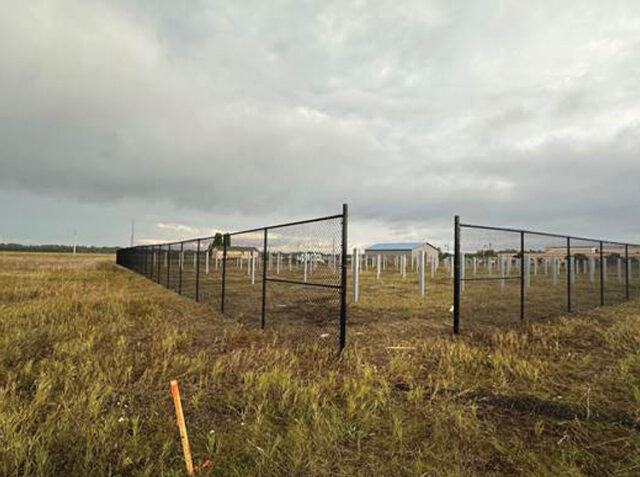By Winona LaDuke
After recent political uncertainty regarding funding for solar energy projects nationwide, a northern Minnesota project on the White Earth Nation reservation called “The Resilience Hub” is finally getting installed. Construction began late this summer and will supply close to 700,000 kilowatt-hours (kWh) of solar, which can be stored in the batteries, for a K-8 school and elderly gathering center, which currently uses almost 800,000 kilowatt-hours annually. The system should be fully operational by early 2026.
The hub will power the Pine Point School which will serve as a resilience hub for the community. Climate justice developer 10Power and community-based renewable energy non-profit 8th Fire Solar are working together to bring the project to fruition. Assets will be owned by the Pine Point School. The project is also providing an Ojibwe educational program, a job fair, and other benefits to a rural community plagued by severe poverty and unemployment.
Project size and energy capacity
The inclusion of energy storage and the magnitude of solar in the project is a first for this region. The installation will include a half megawatt (MW), or 500.8 kilowatts (kW), of direct current solar photovoltaics (PV) and 2.76 megawatt hours (MWh) of battery storage. This will enable solar-generated electrons to be saved and used when the sun is not shining.
The battery will also create emergency backup power during disasters, serving as a critical resource for this underserved community. During peak power times, especially in summer months when the school is not in session, the battery can help regulate the system to feed power back into the grid once policies shift. This means power would be available to the utility when it is needed most, reducing costs for energy retailers and system operators, savings which can potentially be passed to consumers.
“The Pine Point project has faced many political and financial headwinds,” notes Sandra Kwak, 10Power’s CEO. “Although the initial project and funding originated with the Biden Administration’s Bipartisan Inflation Reduction Act (IRA), under Trump’s second term, many projects like this were being eliminated overnight. We persisted and the installation is thankfully underway. It will reduce costs and provide critical services for the Pine Point community. Everyone is excited to see this effort completed soon.”
Recent Headlines Indicated Potential Trouble for the Hub
For a time, the growing headlines about clean energy funding and projects made the hub project seem like an impossibility. “The Trump administration has frozen or canceled more than $29 billion in community environmental and clean energy grants awarded under President Biden, according to a new analysis from the Natural Resources Defense Council, as reported in Inside Climate News.
E&E News reporting was also pessimistic, noting that “U.S. solar deployment could be 21% lower through 2030 than previously forecast, according to a new industry analysis that’s one of the first since the passage of the federal budget bill that phases out wind and solar tax credits.” Meanwhile, “more than $1.2 billion in federal Solar for All funding was allocated for Midwest and Great Plains states, which advocates said would have helped jumpstart the industry in some low-solar-adoption states (Harvest Public Media).

Energy security and sovereignty
“As the project comes online, the Resilience Hub overall will give the White Earth community at Pine Point energy security so that residents can have peace of mind when the grid goes down. They will be alright. Finally, they will not be the first to lose power and the last to get it back,” says Gwe Gasco, Program Coordinator for 8th Fire Solar in Pine Point (where 8th Fire Solar’s small Indigenous workforce manufactures, markets, and installs thermal solar panels). “With the Pine Point School as a hub and an expansion of the already existing solar array with additional panels and a solar battery system to back it up, this timely project will ensure at least one day of comfort and security if the grid fails.”
Against all political and financial odds, The Resilience Hub remained resilient! In June of 2024, Minnesota U.S. Senator Tina Smith announced the allocation of $1.75 million in Federal funding to expand the existing solar array at the Pine Point Elementary School and Community Center. That funding combined with almost $2 million from other grant sources and $1.4 million in tax credits. Finally, additional funding – just under $1 million – was raised from other private funders.
Benefits of the hub
Defying the anti-clean energy headlines and the stark fossil fuel reality of this second Trump term, the benefits for White Earth residents at Pine Point are clear. Historically, they have faced much higher residential energy and economic burdens than much of the rest of Minnesota — the worst in the country at the 97th percentile nationwide. But now the White Earth Indigenous community can create energy security through owning their energy and the means of production, while the Pine Point School will significantly decrease their energy bills.
Besides providing greater energy security, the Hub’s operation will also be used as an educational opportunity for students through an energy curriculum geared toward inspiring students to work in and support renewable energy. And the installation of the solar-plus battery array will help create increased stability and safety within the Pine Point community, allowing residents to stay safer during severe winter storms, providing emergency power to charge critical medical equipment and communication devices, and be a place where people can cook and have access to energy if needed.
After operating expenses, the school is projected to save money each year, depending on utility rates. Even with electrical costs in Minnesota consistently rising, building a solar-plus battery array now will help the Pine Point school, which would otherwise disproportionately feel the effects of rising energy costs, get ahead of the curve, especially in times of extreme weather.
Once completed, all the economic benefits will remain with the Pine Point School as the sole beneficiary of the project. And this project will also provide a basis to educate and raise funds for future clean energy expansions at both Pine Point and the White Earth Nation. It is an important first step in creating a clean energy economy, which generates wealth for members of White Earth.







